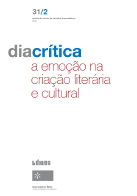MEMORY AND EMOTION. ANALOGIES AND POETIC TRANSPOSITIONS IN PEDRO NAVA’S WORK
DOI:
https://doi.org/10.21814/diacritica.4937Keywords:
Pedro Nava, autobiography, emotion, memoryAbstract
This paper offers a reading of the theme of emotion, focusing on Pedro Nava’s Trunk of bones (1972), Captive balloon (1973), and Iron ground (1976). The theme is examined with reference to the memorialistic discourse of the author but also considering studies in the field of emotion and memory by Paul John Eakin and Patrick Colm Hogan. The aim is to expose how Nava combines discursive domains that are literarily shaped by Aesthetics, History and Psychology to tell life stories.
References
ASSIS, M. (1978). Dom Casmurro. São Paulo: Abril Cultural.
BLOOM, H. (2001). O Cânone Ocidental. Rio de Janeiro: Editora Objetiva.
CAMINHA, E. (1995). Palavra de escritor (2a ed.). Brasília: Editora Thesaurus.
COHEN, P. A. (2014). History and Popular Memory: The Power of Story in Moments of Crisis (1st ed.). New York: Columbia University Press. DOI: https://doi.org/10.7312/cohe16636
CONFINO, A. (2015). Paul A. Cohen. History and Popular Memory: The Power of Story in Moments of Crisis. The American Historical Review, 120(4), 1442-1443. Oxford: Oxford University Press. DOI: https://doi.org/10.1093/ahr/120.4.1442
DAMÁSIO, A. (1996). O erro de Descartes: emoção, razão e o cérebro humano. São Paulo: Companhia das Letras.
EAKIN, P. J. (1985). Fictions in Autobiography: Studies in the Art of Self-Invention. Princeton, New Jersey: Princeton University Press.
FREADMAN, R. (2004). Decent and Indecent: Writing My Father’s Life. In P. J. Eakin (Ed.), The Ethics of Life Writing (pp. 121-46). Ithaca and London: Cornell University Press. HOGAN, P. C. (2008). Stories, Wars, and Emotions: The Absolutness of Narrative Beginnings. In B. Richardson (Ed.), Narrative Beginnings: Theories and Practices (pp. 44-62). Lincoln: University of Nebraska Press.
HOGAN, P. C. (2010). On Being Moved: Cognition and Emotion in Literature and Film. In L. Zunshine (Ed.), Introduction to Cognitive Cultural Studies (pp. 237-56). Baltimore, Maryland: The Johns Hopkins University Press.
HOGAN, P. C. (2011). What Literature Teaches Us About Emotion. Cambridge: Cambridge University Press. DOI: https://doi.org/10.1017/CBO9780511976773
NAVA, P. (1974). Baú de ossos (3a ed.). Rio de Janeiro: José Olympio Editora.
NAVA, P. (1977). Balão cativo (3a ed.). Rio de Janeiro: José Olympio Editora.
NAVA, P. (1976). Chão de ferro. Rio de Janeiro: José Olympio Editora.
PENIDO, P. (1998). Pedro Nava e O Bicho Urucutum. Entrevista de Paulo Penido a Cláudio Aguiar. In: P. Nava Pedro & P. Penido. Pedro Nava: O Bicho Urucutum (pp. 15-48). São Paulo: Ateliê Editorial/ Editora Giordano.
WEBB, E. (1992). Literature in Education: Encounter and Experience. London, New York, Philadelphia: The Falmer Press.
Downloads
Published
How to Cite
Issue
Section
License
Copyright (c) 2023 Maria Alice Ribeiro Gabriel

This work is licensed under a Creative Commons Attribution-NonCommercial 4.0 International License.










